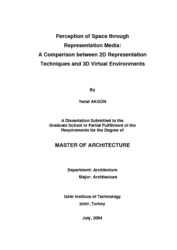Please use this identifier to cite or link to this item:
https://hdl.handle.net/11147/3239Full metadata record
| DC Field | Value | Language |
|---|---|---|
| dc.contributor.advisor | Eyüce, Özen | - |
| dc.contributor.author | Akgün, Yenal | - |
| dc.date.accessioned | 2014-07-22T13:51:10Z | - |
| dc.date.available | 2014-07-22T13:51:10Z | - |
| dc.date.issued | 2005 | en |
| dc.identifier.uri | http://hdl.handle.net/11147/3239 | - |
| dc.description | Thesis (Master)--İzmir Institute of Technology, Architecture, İzmir, 2005 | en |
| dc.description | Includes bibliographical references (leaves: 109-113) | en |
| dc.description | Text in English; Abstract: Turkish and English | en |
| dc.description | xii, 122 leaves | en |
| dc.description.abstract | For centuries, 2D drawing techniques such as plans, sections and elevations have been the main communication media for the profession of architecture. Addition to these techniques, for two decades, computer based representation techniques and 3D virtual environments (VE) have also entered to the profession of architecture. Effects of these computer based techniques on perception of space have always been interrogated by several researches.Although these researches generally regarded these computerized techniques as better and proper than conventional techniques, in some cases conventional techniques can be more effective to depict architectural space. Main aim of this thesis is to compare and evaluate the positive effects and shortcomings of 3D virtual environments and 2D conventional representation techniques in the context of perception of architectural space. Parallel to this objective, the thesis also aims to show the differentiation in perception of space with the change of representation media. To show these differences, a comparative method is used. As the main step of the application of this method, an experimental case study and survey has been constituted for comparing 2D conventional techniques and 3D computer based techniques. In this survey, 38 first yearstudents from Izmir Institute of technology have taken place as test subject.According to the results of this comparative case study, contributions and shortcomings of 2D conventional representation techniques and 3D computer based techniques on improving the capability of architects on perception of the space have been determined. | en |
| dc.language.iso | en | en_US |
| dc.publisher | Izmir Institute of Technology | en_US |
| dc.rights | info:eu-repo/semantics/openAccess | en_US |
| dc.subject.lcc | NA2765 .A31 2005 | en |
| dc.subject.lcsh | Space (Architecture)--Computer programs | en |
| dc.subject.lcsh | Architecture--Computer-aided design | en |
| dc.title | Perception of space through representation media: a comparison between 2D representation techniques and 3D virtual environments | en_US |
| dc.type | Master Thesis | en_US |
| dc.institutionauthor | Akgün, Yenal | - |
| dc.department | Thesis (Master)--İzmir Institute of Technology, Architecture | en_US |
| dc.relation.publicationcategory | Tez | en_US |
| item.languageiso639-1 | en | - |
| item.fulltext | With Fulltext | - |
| item.openairecristype | http://purl.org/coar/resource_type/c_18cf | - |
| item.openairetype | Master Thesis | - |
| item.grantfulltext | open | - |
| item.cerifentitytype | Publications | - |
| Appears in Collections: | Master Degree / Yüksek Lisans Tezleri Sürdürülebilir Yeşil Kampüs Koleksiyonu / Sustainable Green Campus Collection | |
Files in This Item:
| File | Description | Size | Format | |
|---|---|---|---|---|
| T000367.pdf | MasterThesis | 10.61 MB | Adobe PDF |  View/Open |
CORE Recommender
Page view(s)
222
checked on Jul 22, 2024
Download(s)
100
checked on Jul 22, 2024
Google ScholarTM
Check
Items in GCRIS Repository are protected by copyright, with all rights reserved, unless otherwise indicated.